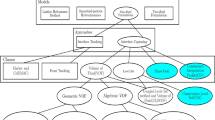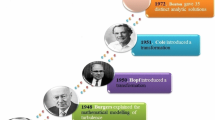Abstract
We summarize some of the recent developments in the field of optimal and suboptimal control strategies for time-dependent incompressible Navier–Stokes equations. Besides the Newton method,reduced order modeling (ROM) and receding horizon control strategies are described. All approaches are applied to compute controls for the unsteady flow around a cylinder in two spatial dimensions.
Similar content being viewed by others
References
Abergel, F. and Temam, R., On some control problems in fluid mechanics. Theoret. Comput. Fluid Dynam. 1 (1990)303–325.
Afanasiev, K. and Hinze, M., Three control methods for time-dependent fluid flow. In: Cagnol, J. (ed.), Shape Optimization & Optimal Design, IFIP Conference, Lecture Notes in Pure and Applied Mathematics. Marcel Dekker, Cambridge (2000) to appear. See also Preprint No. 648/1999, Fachbereich Mathematik, Technische Universität Berlin.
Arian, E., Fahl, M. and Sachs, E., Trust-region proper orthogonal decomposition for flow control. Technical Report, ICASE, NASA Langley Research Center, Hampton, VA (1999).
Atwell, J.A. and King, B.B., Proper Orthogonal Decomposition for reduced basis feedback controllers for parabolic equations. ICAM Report 99–01–01, Interdisciplinary Center for Applied Mathematics, Virginia Polytechnic Institute and State University Blacksburg, VA (1999).
Bänsch, E., An adaptive Finite-Element-Strategy for the three-dimensional time-dependent Navier-Stokes-equations. J. Comput. Math. 36 (1991)3–28.
Bänsch, E., Private communication (1999).
Berggren, M., Numerical solution of a flow control problem: Vorticity reduction by dynamic boundary action. SIAM J. Sci. Statist. Comput. 19(3) (1998)829–860.
Bewley, T., Choi, H., Temam, R. and Moin, P., Optimal feedback control of turbulent channel flow. In: CTR Annual Research Briefs. Center for Turbulence Research, Stanford University/NASA Ames Research Center (1993)pp.3–14.
Bewley, T.R., Moin, P. and Temam, R., DNS-based predictive control of turbulence: An optimal benchmark for feedback algorithms. J. Fluid Mech. (2000) submitted.
Bewley, T., Temam, R. and Ziane, M., A general framework for robust control in fluid mechanics. Physica D 138 (2000)360–392.
Chang, Y. and Collis, S., Active control of turbulent channel flows by large eddy simulation. In: Proceedings of the FEDSM99. ASME, New York (1998)pp.1–8.
Chang, Y. and Collis, S., Computer simulation of active control in complex turbulent flows. Preprint No. 571/1997 (1998).
Choi, H., Suboptimal control of turbulent flow using control theory. In: Proceedings of the International Symposium onMathematical Modelling of Turbulent Flows, Tokyo, Japan (1995).
Choi, H., Hinze, M. and Kunisch, K., Instantaneous control of backward-facing-step flows. Appl. Numer. Math. 31 (1999)133–158. See also Preprint No. 571/1997, Fachbereich Mathematik, Technische Universität Berlin, Deutschland (1997).
Choi, H., Temam, R., Moin, P. and Kim, J., Feedback control for unsteady flow and its application to the stochastic Burgers equation. J. Fluid Mech. 253 (1993) 509.
Clerc, M., Le Tallec, P., Mallet, M., Ravachol, M. and Stouffiet, B., Optimal control for the parabolized Navier-Stokes system. In: Computational Fluid Dynamics '96. JohnWiley & Sons, New York (1996)pp.139–145.
Coron, J.M., On the controllability of the 2-d incompressible Navier-Stokes equations with the Navier slip boundary condition. ESAIM: Control, Optimization and Calculus of Variations 1 (1996)35–75.
Desai, M.C. and Ito, K., Optimal control of Navier-Stokes equations. SIAM J. Control Optim. 32 (1994)1428–1446.
Fabre, C., Uniqueness results for the Stokes equations and their consequences in linear and nonlinear control problems. ESAIM: Control, Optimization and Calculus of Variations 1 (1996) 267–302.
Fursikov, A.V., Exact boundary zero controllability of three-dimensional Navier-Stokes equations. J. Dynam. Control Systems 1 (1995)325–350.
Fursikov, A.V., Gunzburger, M.D. and Hou, L.S., Boundary value problems and optimal boundary control for the Navier-Stokes system: The two-dimensional case. SIAM J. Control Optim. 36 (1998)852–894.
Ghattas, O. and Bark, J., Optimal control of two-and three-dimensional incompressible Navier-Stokes flows. J. Comput. Phys. 136 (1997)231–244.
Glowinski, R., Finite element methods for the numerical simulation of incompressible viscous flow. In: Introduction to the Control of the Navier-Stokes Equations. Lectures in Applied Mathematics, Vol. 28. American Mathematical Society, Providence, RI (1991)pp.219–301.
Gunzburger, M.D., Flow Control. IMA. Springer-Verlag, Berlin (1995).
Gunzburger, M.D., Hou, L.S. and Svobodny, T.P., Analysis and finite element approximation of optimal control problems for the stationary Navier-Stokes equations with Dirichlet boundary controls. M2AN 25(6) (1991)711–748.
Gunzburger, M.D. and Manservisi, S., Analysis and approximation for linear feedback control for tracking the velocity in Navier-Stokes flows. Preprint (1999) to appear.
Gunzburger, M.D. and Manservisi, S., Analysis and approximation of the velocity tracking problem for Navier-Stokes flows with distributed control. SIAM J. Numer. Anal. (1999) to appear.
Gunzburger, M.D. and Manservisi, S., The velocity tracking problem for Navier-Stokes flows with boundary controls. SIAM J. Control Optim. (1999) to appear.
Gunzburger, M.D. and Manservisi, S., The velocity tracking problem for Navier-Stokes flows with bounded distributed controls. SIAM J. Contr. Optim. (1999) to appear.
Heinkenschloss, M., Private communication (1999).
Heinkenschloss, M., Time-domain decomposition iterative methods for the solution of discretized linear quadratic optimal control problems. Draft, Department of Computational and Applied Mathematics, Rice University, Houston, TX (1999).
Heinkenschloss, M., Formulation and analysis of a sequential quadratic programming method for the optimal Dirichlet boundary control of Navier-Stokes flow. Report TR97–14, Department of Computational and Applied Mathematics-MS134, Rice University Houston, TX (1997). See also Hager, W.W. and Pardalos, P.M. (eds), Optimal Control: Theory, Algorithms, and Applications. Kluwer Academic Publishers, Dordrecht (1998)pp.178–203.
Heywood, J.G., Rannacher, R. and Turek, S., Artificial boundaries and flux and pressure conditions for the incompressible Navier-Stokes equations. Internat. J. Numer. Methods Fluids 22 (1996)325–352.
Hinze, M., Optimal and instantaneous control of the instationary Navier-Stokes equations. Habilitationsschrift, Fachbereich Mathematik, Technische Universität Berlin (1999).
Hinze, M. and Kauffmann, A., Control concepts for parabolic equations with an application to the control of fluid flow. In: Scientific Computing in Chemical Engineering II, Hamburg Harburg, Springer-Verlag, Berlin (1999). Preprint No. 603/1998, Technische Universität Berlin, Deutschland.
Hinze, M. and Kunisch, K., Control strategies for fluid flows-Optimal versus suboptimal control. In: Bock, H.G. et al. (eds), ENUMATH 97.World Scientific, Singapore (1997)pp.351–358.
Hinze, M. and Kunisch, K., On suboptimal control strategies for the Navier-Stokes equations. Preprint No. 568/1997, Technische Universität Berlin (1997). See also ESAIM: Proceedings 4 (1998) 181–198, http://www.emath.fr/proc/Vol.4, France (1998).
Hinze, M. and Kunisch, K., Suboptimal control strategies for backward facing step flows. In: Sydow, A. (ed.), Proceedings of the 15th IMACS World Congress on Scientific Computation, Modelling and Applied Mathematics, Vol. 3. Berlin (1997)pp.53–58.
Hinze, M. and Kunisch, K., Newton's method for tracking-type control of the instationary Navier-Stokes equations. In: Neittaanmäki, P. et al. (eds), ENUMATH 99, Jyvdskyla, Finland (1999) to appear.
Hinze, M. and Kunisch, K., Second order methods for optimal control of time-dependent fluid flow. Bericht Nr. 165, Spezialforschungsbereich Optimierung und Kontrolle, Institut für Mathematik, Karl-Franzens-Universität Graz (1999).
Hinze, M. and Volkwein, S., Instantaneous control for the Burgers equation: Convergence analysis and numerical implementation. Bericht Nr. 170, Spezialforschungsbereich Optimierung und Kontrolle, Institut für Mathematik, Karl-Franzens-Universität Graz (1999).
Hou, L.S., Gunzburger, M.D., Manservisi, S., Turner, J. and Yan, Y. Computations of optimal controls for incompressible flows. Internat. J. Comp. Fluid Dyn., to appear.
Hou, L.S. and Svobodny, T.P., Optimization problems for the Navier-Stokes equations with regular boundary controls. J. Math. Anal. Appl. 177 (1993)342–367.
Hou, L.S. and Yan, Y., Dynamics and approximations of a velocity tracking problem for the Navier-Stokes flows with piecewise distributed controls. SIAM J. Control Optim. 35 (1997)1847–1885.
Hou, L.S. and Yan, Y., Dynamics for controlled Navier-Stokes Systems with distributed controls. SIAM J. Control Optim. 35 (1997)654–677.
Ito, K. and Kang, S., A dissipative feedback control synthesis for systems arising in fluid dynamics. SIAM J. Control Optim. 32 (1994)831–854.
Ito, K. and Kunisch, K., Asymptotic properties of receding horizon optimal control problems. Preprint, Institut für Mathematik, Universität Graz (2000).
Ito, K. and Ravindran, S.S., Reduced basis method for optimal control of unsteady viscous flow. J. Guidance, Control Dynam. (1997) submitted.
Ito, K. and Ravindran, S.S., A reduced basis method for control problems governed by pdes. In: Desch W. et al. (eds), Control and Estimation of Distributed Parameter Systems, International Conference in Vorau, Austria, July 14–20, 1996, International Series on Numerical Mathematics, Vol. 126. Birkhäuser, Basel (1998)pp.153–168.
Joshi, S.S., Speyer, J.L. and Kim, J., A system theory approach to the feedback stabilization of infinitesimal and finite-amplitude disturbances in plane Poiseuille flow. J. Fluid Mech. 332 (1997) 157–184.
Joslin, R.D., Gunzburger, M.D., Nicolaides, R.A., Erlebacher, G. and Hussaini, M.Y., A methodology for the automated optimal control of flows including transitional flows. In: Proceedings ASME Forum on Control of Transitional and Turbulent Flows Vol. FED-237. ASME, New York (1996)pp.287–294.
Justen, P., Optimal control of thermally coupled Navier-Stokes equations in food industry. Preprint, Fachbereich IV-Mathematik, Universität Trier (1998).
Koumoutsakos, P., Active control of turbulent channel flow. Report, Center of Turbulence Research, Stanford, CA (1997).
Koumoutsakos. P., Active control of vortex-wall interactions. Phys. Fluids 9 (1997)3808–3816.
Koumoutsakos, P., Vorticity flux control for a turbulent channel flow. Report, Institut für Fluidmechanik, ETH Zürich, Switzerland (1998).
Kunisch, K. and Marduel, X., Optimal control of non-isothermal viscoelastic fluid flow. Bericht, Spezialforschungsbereich Optimierung und Kontrolle, Institut für Mathematik, Karl-Franzens-Universität Graz (1998). J. Non-Newtonian Fluid Mech., to appear.
Kunisch, K. and Marduel, X., Suboptimal control of transient non-isothermal viscoelastic fluid flow. Bericht, Spezialforschungsbereich Optimierung und Kontrolle, Institut für Mathematik, Karl-Franzens-Universität Graz (1999).
Kunisch, K. and Volkwein, S., Control of Burgers equation by a reduced order approach using Proper Orthogonal Decomposition. J. Optimization Theory Appl. 102 (1999)345–371.
Lee, C., Kim, J., Babcock, D. and Goodman, R., Application of neural networks to turbulence control for drag reduction. Phys. Fluids 9(6) (1997)1740–1747.
Lee, C., Kim, J. and Choi, H., Suboptimal control of turbulent channel flow for drag reduction.
Loncaric, J., Optimal control of unsteady Stokes flow around a cylinder and the sensor/actuator placement problem. ICASE Report No. 98–18, NASA, Langley Research Center (1998).
Málek, J. and Roubiček, T., Optimization of steady flows for incompressible viscous fluids. In: Sequiera, A. et al. (eds), Nonlinear Applied Analysis (1999)pp.355–372.
Manservisi, S., Optimal boundary and distributed controls for the velocity tracking problem for Navier-Stokes flows. Ph.D. Thesis, Faculty of the Virginia Polytechnic Institute and State University, Blacksburg, VA (1997).
Min, C. and Choi, H., Suboptimal feedback control of vortex shedding at low Reynolds numbers. J. Fluid Mech. 401 (1999)123–156.
Protas, B. and Styczek, A., Theoretical and computational study of the wake control problem. Preprint, Department of Aerodynamics, Warsaw University of Technology, Warsaw, Poland (1998).
Rannacher, R., Finite element methods for the incompressible Navier-Stokes equations. Preprint 1999–37, Sfb 359, Universität Heidelberg, Germany (1999).
Ravindran, S.S., Proper orthogonal decomposition in optimal control of fluids. Technical Report, NASA Langley Research Center, Hampton, VA (1999).
Schafer, M. and Turek, S., Benchmark computations of laminar flow around a cylinder. In: Hirschel, E.H. (ed.), Flow Simulation with High-Performance Computers II. DFG Priority Research Programme Results 1993–1995, Notes in Numerical Fluid Mechanics, Vol. 52. Vieweg, Wiesbaden (1996)pp.547–566.
Sirovich, L., Turbulence and the dynamics of coherent structures, Part I-III. Quart. Appl. Math. 45 (1987)561–590.
Sritharan, S. (ed.), Optimal Control of Viscous Flow. SIAM, Philadelphia, PA (1998).
Tang, K.Y., Graham, W.R. and Peraire, J., Optimal control of vortex shedding using low-order models. I: Open loop model development. II: Model based control. Internat. J. Numer. Methods Engrg. 44 (1999)945–990. See also AIAA paper No. 1996–19–46.
Temam, R., Navier-Stokes Equations. North-Holland, Amsterdam (1979).
Temam, R., Bewley, T. and Moin, P., Control of turbulent flows. In: Proceedings of the 18th IFIP TC7 Conference on System Modelling and Optimization, Detroit, MI (1997).
Author information
Authors and Affiliations
Rights and permissions
About this article
Cite this article
Hinze, M., Kunisch, K. Three Control Methods for Time-Dependent Fluid Flow. Flow, Turbulence and Combustion 65, 273–298 (2000). https://doi.org/10.1023/A:1011417305739
Issue Date:
DOI: https://doi.org/10.1023/A:1011417305739




